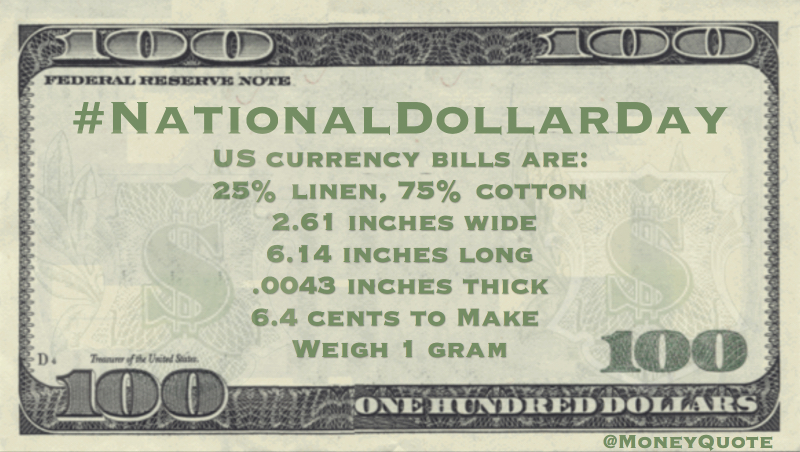One Dollar Bill – Stats & Info: Infographic
on Sunday, November 4, 2012#NationalDollarDay August 8 Everything you want to know about dollars on National Dollar Day.

LIFE, DEATH of the ONE DOLLAR BILL
BIRTH
- US currency bills are 2.61 inches wide
- 6.14 inches long
- They are .0043 inches thick
- Weigh 1 gram
- It costs the US government 6.4 cents to produce a U.S. bill
- Bills are composed of 25% linen and 75% cotton
- red and blue synthetic fibers are distributed throughout the paper
- Bills are made from a blend of linen and cotton, which is why they don’t fall apart in the wash the way paper does

Share the #NaitonalDollarDay Money stats image above on your site:
LIFE
The Bureau of Engraving and Printing prints about 16,600,000 $1 bills each day. Most are used to replace worn, older bills. There are currently 4 BILLION $1 bills in circulation. Approximately 45% of all U.S. currency produced today are $1 bills.
The black seal with the big letter in the middle signifies the Federal Reserve bank that placed the order for the bill. The letter also corresponds to the black number that is repeated four times on the face of the bill. For example, if you have a bill from Dallas with the letter K, then the number on the bill will be 11 because K is the eleventh letter in the alphabet.
- A = Boston
- B = New York City
- C = Philadelphia
- D = Cleveland
- E = Richmond VA
- F = Atlanta
- G = Chicago
- H = St. Louis
- I = Minneapolis
- J = Kansas City
- K = Dallas
- L = San Francisco
The Treasury Department sends newly printed bills to each of the Federal Reserve banks, which in turn send the money out to banks, credit unions, and savings and loans institutions. From there, people withdraw the cash and begin to use it to shop and pay bills.
New, crisp dollar bills enter the money cycle by being paid into the U.S. Federal Reserve system.
Treasury Department to Federal Reserve Banks to Credit Unions, S&L, Banks
FBI chemists have discovered that traces of cocaine can be found on almost every dollar bill in circulation. However because cocaine is a fine powder and is easily spread around, presence of the drug does not necessarily mean the bill was used as a snorting straw.
Since 1973, the dollar bill has had no value tied to it. As opposed to the British pound, where each currency note has a direct value attached to it based on the silver reserves England owns (1 pound note = 1 pound sterling silver).
DEATH
Banks collect torn, damaged or badly soiled bills by separating them out daily from what they collect from the public. Banks can exchange the old, worn out money for new bills at the Federal Reserve Bank and determines if it is ready to be retired from the money system. It it is not, the bills are recirculated through the banks. The Federal Reserve Banks collect the worn out currency in large quantities, then the money is shredded. A $1 bill usually lasts about 21 months in regular circulation
If you have a badly damaged bill, you can usually redeem it at your bank. As long as there is more than half of the bill left, your bank will exchange it for you. IF the bill is too damaged for the bank to accept, you can still try redeeming it by sending the remains of the bill to the Treasury Department and asking them to redeem it. If it is possible to determine the bills value and if the missing parts of the bill have have not already been redeemed, the Treasury will redeem it for you.
Short Link to this Page:

You must be logged in to post a comment.